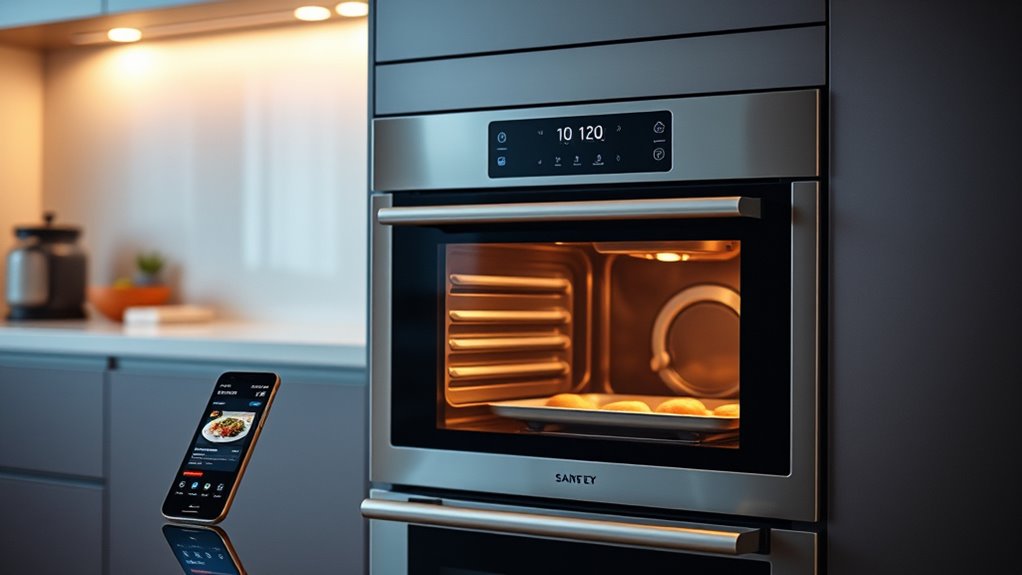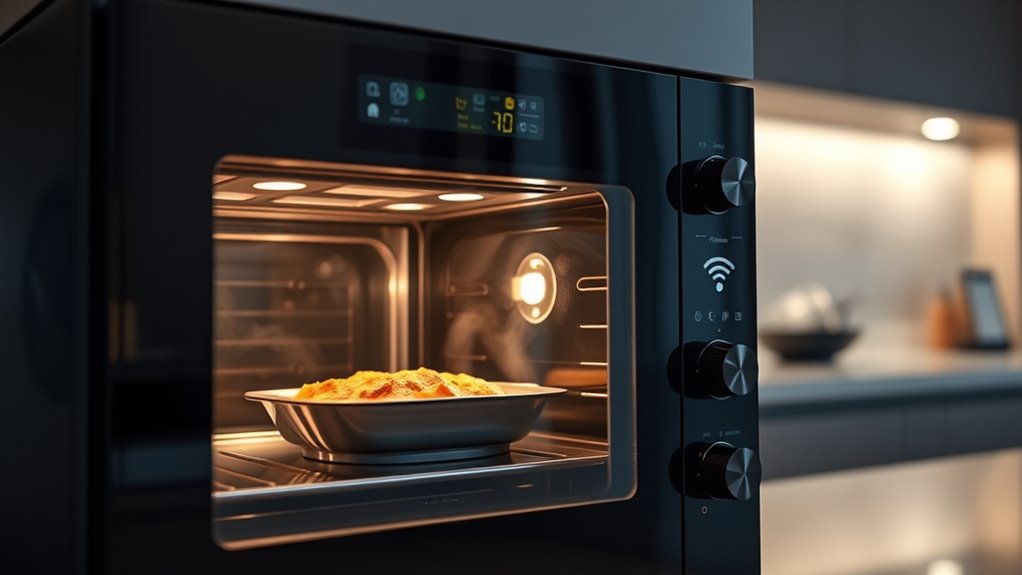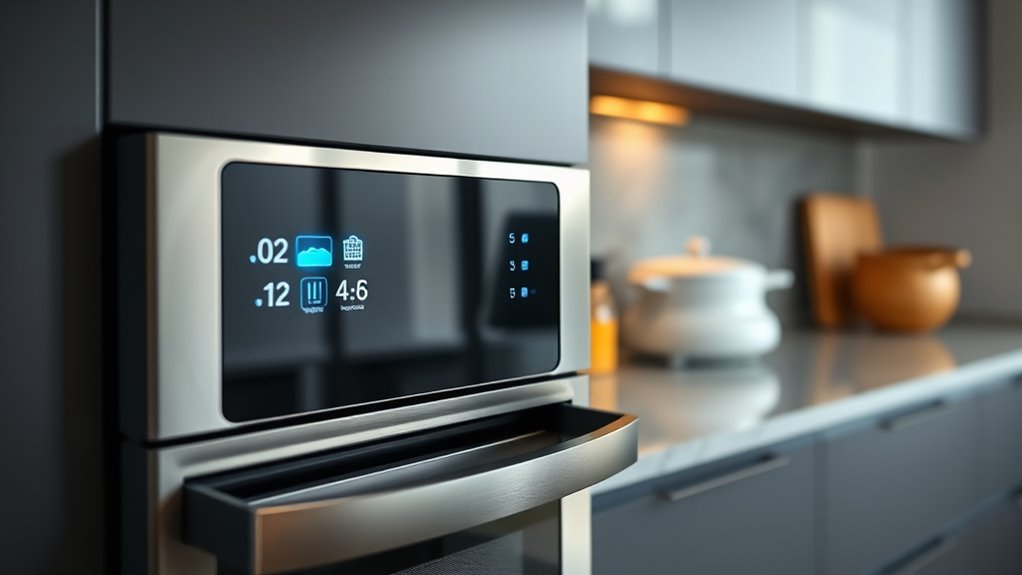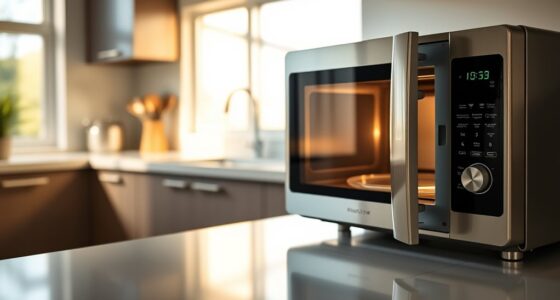Smart ovens combine traditional heating with digital tech like sensors and connectivity, allowing you to control and monitor cooking remotely. They automatically adjust temperature and time based on recipes and sensor data, making cooking more precise and energy-efficient. While they don’t truly “think,” they mimic decision-making through programmed responses and algorithms. Curious how these features work together to improve your cooking? Explore further to discover how smart ovens are transforming kitchen experiences.
Key Takeaways
- Smart ovens use sensors and algorithms to automatically adjust temperature and cooking time based on food status.
- They can be remotely controlled via apps or voice commands, enhancing convenience and precision.
- These ovens mimic decision-making but do not possess genuine consciousness or human-like thinking.
- They operate within programmed parameters, optimizing energy use and cooking results without true independent thought.
- While highly advanced, smart ovens are devices that simulate thinking through data analysis and automation, not actual cognition.
How Do Smart Ovens Work?

Smart ovens work by combining traditional heating elements with advanced digital technology, allowing you to control and monitor cooking remotely. With voice control, you can give commands hands-free, making cooking more convenient. These ovens use sensors and smart algorithms to adjust temperature and cooking time automatically, optimizing energy efficiency. Instead of wasting energy, they heat precisely when needed, reducing electricity consumption and lowering your utility bills. Additionally, application timing can be optimized through these features to ensure perfect results. You can set timers, change settings, or check cooking progress through your smartphone or voice commands. This integration of digital features ensures your oven operates efficiently while giving you greater control over your culinary tasks. Overall, smart ovens make cooking smarter, more efficient, and more accessible through intuitive technology.
Features That Make Ovens “Smart”

What features truly set modern ovens apart as “smart”? One key aspect is voice control, allowing you to operate your oven hands-free. Just say commands like “preheat to 350 degrees” or “start baking,” and your oven responds instantly. This makes cooking more convenient and accessible. Another essential feature is recipe integration, where your oven connects to apps or online databases to guide you through cooking processes. It can automatically adjust temperature and cooking time based on specific recipes, ensuring perfect results every time. These features work together to create a seamless cooking experience, making your oven not just an appliance but an intelligent assistant in your kitchen. With voice control and recipe integration, your oven becomes more intuitive and user-friendly. Additionally, predictive analytics can help optimize cooking parameters by analyzing your preferences and cooking history, further enhancing the smart oven experience.
The Technology Behind Intelligent Cooking

Behind the user-friendly features like voice control and recipe integration lies a sophisticated network of sensors, algorithms, and connectivity technologies. These components work together to monitor and adjust cooking processes in real-time, ensuring ideal results. Voice control allows you to give commands hands-free, making cooking more convenient. Advanced sensors detect temperature, humidity, and food progress, helping the oven adapt automatically. Connectivity enables remote monitoring and control through apps, improving energy efficiency by preventing unnecessary power use. Algorithms analyze data from sensors to fine-tune cooking parameters, maintaining perfect results with minimal user input. This technological foundation makes intelligent cooking possible, blending convenience, precision, and energy savings seamlessly. Understanding refrigeration cycle is essential for optimizing appliance performance and energy efficiency.
Are Smart Ovens Truly Capable of Thinking?

Are smart ovens truly capable of thinking like humans? Not quite, but they do mimic some aspects of human decision-making through features like voice control. You can tell your oven what to do, and it responds intelligently, adjusting cooking times or temperatures based on your commands. Additionally, some smart ovens incorporate Ice Cream Recipes to suggest dessert options or even help in preparing frozen treats, enhancing their versatility in the kitchen. However, this isn’t real thinking; it’s programmed responses and algorithms. Smart ovens also prioritize energy efficiency by optimizing heat use and cooking cycles, saving you electricity and reducing waste. They analyze data from sensors and your inputs, but they lack consciousness or genuine understanding. So, while they seem smart and responsive, they don’t think independently like humans—they operate within predefined parameters designed to improve convenience and efficiency.
The Pros and Cons of Using Smart Ovens

Smart ovens offer several advantages that can make cooking more convenient and efficient. They often improve energy efficiency by adjusting cooking times and temperatures automatically, helping you save on utility bills. Plus, they enhance user convenience with features like remote control and step-by-step guidance, making cooking simpler even for beginners. However, there are some downsides. They tend to be more expensive upfront, and their advanced technology can sometimes be unreliable or confusing to use. Additionally, they may require regular updates and maintenance, which can be inconvenient. Despite these drawbacks, many users find the added functionality worth the investment, especially when it comes to saving time and energy. Furthermore, understanding the emotional support needs related to adopting new technology can help users feel more confident with their purchase decisions. Overall, weighing the pros and cons helps you decide if a smart oven fits your kitchen needs.
Frequently Asked Questions
What Brands Currently Offer the Most Advanced Smart Ovens?
You’ll find that brands like Samsung, LG, and GE lead with the most advanced smart ovens. These models often feature voice control, allowing you to operate them hands-free, and emphasize energy efficiency to save power. Their smart technology adapts to your cooking habits, providing precise temperature control and remote monitoring. Investing in these brands guarantees you get innovative features that make cooking easier, more efficient, and more connected to your daily life.
How Secure Is My Data When Using a Smart Oven?
Data security remains a concern when using smart ovens. You worry about privacy concerns, but manufacturers often implement robust data encryption to protect your information. Still, it’s wise to stay vigilant by regularly updating software and reviewing privacy policies. While your data’s safety isn’t guaranteed, proactive precautions can prevent potential breaches. Remember, smart ovens are designed with security in mind, but your awareness and actions play a vital role in safeguarding your data.
Can Smart Ovens Be Integrated With Other Smart Home Devices?
You can easily integrate smart ovens with other smart home devices, enhancing your convenience through voice control and automation. By linking your oven with smart speakers or hubs, you can control cooking settings hands-free, making meal prep simpler. Plus, these integrations often promote energy efficiency by enabling remote monitoring and scheduling. As a result, your smart home becomes more cohesive, giving you greater control and saving you time and energy.
What Is the Typical Price Range for a High-End Smart Oven?
Think of a high-end smart oven as a luxury car—you get advanced features and sleek design. The price range typically falls between $2,000 and $5,000, depending on brand and features. If you’re looking for affordability options, some models start around $1,000. Consider your cooking needs and budget to find the perfect balance between innovation and value, ensuring your kitchen stays smart and stylish without breaking the bank.
How Reliable Are Smart Oven Sensors Over Time?
When it comes to smart oven sensors, you’re probably wondering about their reliability over time. You should know that sensor calibration is key to maintaining accuracy, but long-term durability can vary. Regular calibration helps make certain sensors stay accurate, and many high-quality models are built to last several years. However, like any tech, they may need occasional replacement or adjustment to keep your oven performing at its best.
Conclusion
Imagine your smart oven as a helpful assistant, gently guiding your meals from raw ingredients to perfectly cooked dishes. With its intuitive sensors and connected features, it feels like it’s almost thinking for you, making cooking easier and more enjoyable. While it may not have a human mind, its clever technology transforms your kitchen into a futuristic space where delicious meals are just a tap away. Embrace the convenience and let your smart oven bring your culinary visions to life.









